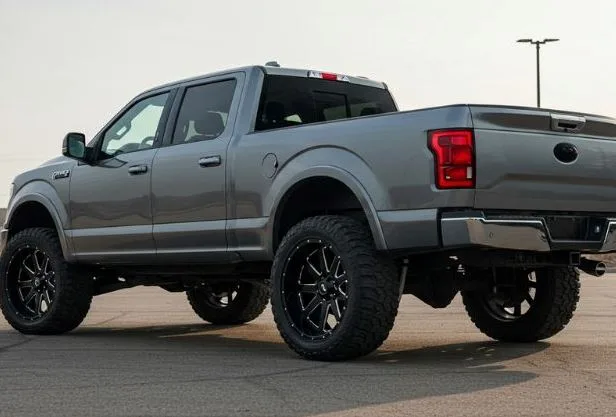Staggered vs Non-Staggered Wheels: Why Most People Choose Wrong
The staggered wheels vs. square setup debate creates more confusion than almost any other modification choice. Walk into a tire shop, and half the staff will push staggered setups, while the other half swears by square configurations. Both sides present compelling arguments, but most people overlook the crucial details that ultimately determine which approach is more effective.
The reality? Neither setup is universally superior. Staggered wheels excel in specific situations, while square setups dominate others. The key lies in matching the configuration to actual driving habits rather than following generic recommendations or Instagram trends.
Here’s what actually determines whether staggered or non-staggered wheels make sense for different applications and budgets.
What You Should Know
- Staggered means wider rear tires: Creates more rear grip but prevents tire rotation
- Square setups use identical sizes: All four corners match for easier maintenance
- Performance differences are real: Each configuration affects handling characteristics differently
- Cost impacts vary significantly: Square setups often save money long-term through rotation
- Vehicle type matters: RWD cars benefit more from staggered than FWD vehicles
- Maintenance complexity differs: Square setups simplify tire management considerably
Staggered vs Square: The Actual Differences
Most explanations of staggered and non-staggered setups focus on obvious visual differences while missing performance implications.
Staggered Setup Reality
Staggered wheels feature wider rear tires compared to front tires, creating an aggressive stance and potentially improving traction. A typical staggered fitment might feature 245/40R18 front tires with 275/35R18 rears, or even more dramatic differences, such as 8.5-inch front wheels with 9.5-inch rears. Many people upgrade to 22-inch rims in staggered configurations for maximum visual impact.
This configuration affects more than just appearance. The wider rear tire creates a larger contact patch, which can improve acceleration and grip, particularly beneficial for rear-wheel-drive vehicles. Cars like the BMW M3 and Ford Mustang often feature staggered fitments from the factory, as their power delivery benefits from extra rear traction.
However, staggered setups prevent tire rotation between front and rear positions. This limitation means that front tires typically wear out faster than the rears, creating replacement timing issues and higher long-term costs.
Square Setup Advantages
Square or non-staggered setups use identical tire sizes on all four corners. This uniformity allows complete tire rotation, extending overall tire life and maintaining balanced wear patterns across the entire set.
The square tire setup also simplifies maintenance since pressure requirements, replacement timing, and performance characteristics remain consistent. For daily drivers, this consistency provides predictable handling and easier tire management.
Square setups particularly benefit front-wheel-drive vehicles by reducing understeer tendencies. When front tires match rears, weight transfer during cornering affects all four corners similarly, creating more balanced handling characteristics.
Performance Impact Breakdown
Real-world performance differences between staggered and square setups depend heavily on vehicle type and driving style.
Staggered Performance Benefits
Staggered wheels provide measurable traction improvements for rear-wheel-drive vehicles during acceleration. The wider rear tire creates more contact patches, allowing better power transfer to the road surface. This becomes particularly noticeable in high-powered cars where wheel spin limits acceleration.
Cornering performance can also improve with staggered setups, especially in cars with rear weight bias. The wider rear tire helps maintain grip through corners, while the narrower front tire reduces steering effort and improves turn-in response.
Track driving often favors staggered configurations because the enhanced rear grip allows more aggressive driving styles. Cars with staggered fitments typically oversteer more predictably, which experienced drivers can use to rotate the car through tight corners.
Square Setup Performance Characteristics
Square tire setups excel in providing consistent, predictable handling across various conditions. Since all four tires share identical characteristics, the car behaves more uniformly during different driving scenarios.
For front-wheel-drive vehicles, square setups often improve overall balance by preventing excessive understeer. When the front and rear tires match, the car turns more neutrally and responds better to driver inputs.
Daily driving scenarios typically favor square configurations because they provide consistent performance without requiring specialized driving techniques. The balanced feel appeals to drivers who prioritize smooth, predictable handling over maximum performance.
Cost Analysis: Staggered vs Square
Long-term ownership costs differ significantly between staggered and square wheel setups.
Square Setup Cost Advantages
Tire Rotation
- Square Setup: Every 5,000 miles
- Staggered Setup: Not possible
- Annual Difference: $200–$400 saved
Replacement Timing
- Square Setup: All four tires replaced together
- Staggered Setup: Front/rear replaced separately
- Annual Difference: $150–$300 saved
Tire Selection
- Square Setup: One size to research
- Staggered Setup: Two sizes needed
- Annual Difference: Time savings
Inventory
- Square Setup: Single spare type
- Staggered Setup: Two spare types
- Annual Difference: Storage simplification
Square setups enable drivers to purchase four identical tires and rotate them regularly, thereby maximizing tire lifespan. This rotation capability often extends tire life by 15-25% compared to staggered configurations where front tires wear faster.
The ability to replace all four tires simultaneously also provides better deals from tire retailers who offer set discounts. Many shops provide significant savings for four-tire purchases compared to buying pairs separately.
Staggered Setup Cost Reality
Staggered wheels typically cost more in the long run because the front and rear tires wear at different rates. Front tires usually need replacement 20-30% sooner than rears, creating awkward replacement timing and preventing bulk purchase discounts.
The inability to rotate tires also means drivers cannot compensate for slight alignment issues or uneven wear patterns. Any problems that would usually be managed through rotation become permanent tire wear issues.
High-performance 22-inch rims in staggered configurations accentuate these cost differences, as larger tires are more expensive to replace and tend to wear out faster than smaller alternatives.
Vehicle-Specific Recommendations
Different drivetrains and vehicle types benefit more from specific wheel configurations.
Rear-Wheel-Drive Applications
Rear-wheel-drive vehicles like the BMW M3, Mustang, and other performance cars often benefit from staggered setups. The wider rear tire helps transfer power to the ground more effectively, reducing wheel spin and improving acceleration.
Cars with significant rear weight bias also handle better with staggered fitments because the wider rear tire compensates for the extra weight over the rear axle. This combination creates more balanced handling than square setups in many RWD applications.
However, daily-driven RWD cars that prioritize comfort over performance may still benefit from square setups due to their maintenance and cost advantages.
Front-Wheel-Drive Considerations
Front-wheel-drive vehicles rarely benefit from staggered wheels because their weight distribution and power delivery don’t take advantage of wider rear tires. The front wheels handle both steering and acceleration, making the front tire choice more critical than the rear.
Square setups typically work better for FWD cars because they allow tire rotation and provide consistent handling. The ability to move tires from front to rear helps manage the heavier wear that front tires experience in FWD applications.
All-wheel-drive vehicles fall somewhere between these extremes, with the optimal choice depending on power distribution and intended use.
Maintenance Reality Check
Day-to-day ownership differences between staggered and square setups affect long-term satisfaction.
Square Setup Simplicity
Square tire setups simplify every aspect of tire maintenance. Pressure checks require one setting, rotations follow standard patterns, and replacement planning becomes straightforward. This simplicity appeals to drivers who want minimal maintenance complexity.
When visiting tire shops or wheel places like Discounted Wheel Warehouse, square setups make inventory management easier, as only one tire size needs to be stocked. This often translates to better availability and pricing.
Staggered Setup Complexity
Staggered wheels require tracking two different tire sizes, pressures, and wear patterns. Front and rear tires require different replacement schedules, which complicates maintenance planning and budget forecasting.
Finding matching replacement tires can also become challenging, especially for unusual sizes or discontinued models. Having two different tire specifications doubles the chance of availability issues.
Performance Comparison Table
Tire Rotation
- Square Setup: Full rotation possible
- Staggered Setup: No rotation
- Winner: Square
RWD Acceleration
- Square Setup: Good
- Staggered Setup: Better
- Winner: Staggered
FWD Handling
- Square Setup: Better
- Staggered Setup: Good
- Winner: Square
Maintenance Cost
- Square Setup: Lower
- Staggered Setup: Higher
- Winner: Square
Track Performance
- Square Setup: Good
- Staggered Setup: Better (RWD)
- Winner: Depends
Daily Driving
- Square Setup: Excellent
- Staggered Setup: Good
- Winner: Square
Expert Perspective: Real-World Testing
According to Motor Trend’s comprehensive wheel testing program, staggered configurations show measurable performance advantages in rear-wheel-drive vehicles during acceleration and cornering tests. However, their analysis revealed that these benefits primarily appear during aggressive driving scenarios that represent less than 5% of typical vehicle usage.
Source: Motor Trend
The publication’s testing data indicates that while staggered setups provide clear performance gains in controlled environments, square configurations offer superior value for most real-world driving applications because of their maintenance advantages and cost-effectiveness.
Making the Right Choice in 2025
Choose a square setup if daily driving is the primary usage, budget is a concern, or the car has front-wheel drive. The simplicity of maintenance and cost savings make square configurations practical for most applications.
Consider a staggered setup if the car is rear-wheel drive, track days occur regularly, or maximum performance takes priority over convenience. Staggered wheels excel in performance applications where their advantages get used.
Avoid staggered if tire rotation is essential for budget management, the car is exposed to harsh weather, or convenience takes priority over performance. Staggered setups create ongoing complications that are not suitable for many drivers.
The decision ultimately depends on an honest assessment of driving habits and priorities. Most drivers benefit more from square setups, despite the staggered wheels’ performance advantages, because they rarely use cars in ways that exploit those benefits.
Frequently Asked Questions
- Can you rotate tires on staggered wheels? No, staggered setups prevent tire rotation because front and rear sizes differ. This limitation leads to uneven wear patterns and higher replacement costs compared to square setups, which allow for full rotation.
- Do staggered wheels improve performance? Staggered wheels can improve acceleration and cornering performance in rear-wheel-drive vehicles by providing more rear grip. However, the benefits mainly appear during aggressive driving, which most people rarely experience.
- Are staggered wheels worth the extra cost? Staggered wheels are worth the extra cost for serious performance applications like track driving or racing. For daily driving, square setups usually provide better value through lower maintenance costs and longer tire life.





